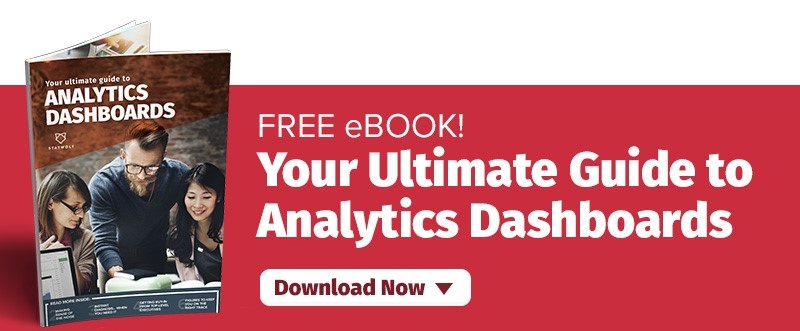How the science of analytics could revolutionise your industry
We live in the age of Big Data. Masses and masses of data are available at our fingertips. A simple Google search for “too much data” returns over 54 million responses. It’s no surprise that businesses around the world are trying to figure out how best to interpret their data – but the amount is staggering.
According to a recent study, only 37 percent of organisations said that they have successfully adopted a data-driven culture. The key to optimising the use of your company’s data is to make sure there is a holistic approach across the whole organisation.
There is no point in your sales team generating its own data if the finance side of your business can’t access it. Data analytics works best when not only have free access to all your data, but also have the freedom to interrogate it.
But how do you interrogate it?
Bernard Marr of Forbes gave the example of the seminal science fiction film (and book) The Hitchhikers Guide to the Universe. In it, the humans ask the machine what the meaning of life is. The machine answers 42. The humans protest and say this makes no sense. The machine responds by saying the answer is correct; it’s the question that isn’t right.
You need to ask the right questions of the right data.
How asking the right question changed the game of basketball forever
When it comes to the question of analytics in sports, most people turn to the example of the Oakland As in baseball, who used advanced metrics to find players that other traditional teams overlooked. The As had one of the lowest wage bills, but were consistently one of the best teams in the game.
Michael Lewis wrote a book about them and it even ended up as an Oscar-winning movie starring Brad Pitt. But while analytics helped to adapt one baseball team, the entire game of basketball was changed forever by analytics.
Basketball followed pretty much the same path since it was invented over 100 years ago. Teams worked the ball to their tall players near the basket, who used their size to take high-efficiency, short-range shots. Smaller players had to either compete with the tall players or take lower-efficiency long-range shots. In 1979, basketball authorities decided to reward some of those long-range shots by creating a three-point shot for all shots outside of 21 feet.
The game rumbled on unchanged for another 20 years until basketball teams started to hire data analysts who finally asked the right question – “why aren’t we exploiting the fact that the three-point shot is worth 50 percent more than any other shot?”
It seems an obvious point, but the traditionalists had said that the three-point shot was too risky and you’d never win a championship by shooting three-pointers. The dominant team in the NBA right now are the Golden State Warriors. They’ve won two out of the last three championships and fire up three-point attempts at a higher rate than any team ever.
Their analysts found that they had some of the best three-point shooters in the game and encouraged management to let the players shoot more. The New York Times reported that the analysts figured out that, “a team would have to shoot 60 percent on two-pointers to match the offensive output of a team that shoots 40 per cent from [three-point range].”
The Warriors were mocked at first. But after two championships in three years, nobody is laughing now.
Indeed, the trend is a league-wide one. As recently as 2006, NBA teams averaged 16 three-point attempts per game. In 2017, teams made 27 attempts per game – an increase of 33 percent. The game is no longer reliant on the tall players.
The most effective player in basketball is Steph Curry – a comparatively small, slight player (Curry is 6ft 3in – which is tiny in NBA circles) – who has taken more three-point shots per season than any player in history.
And all because basketball hired analysts who weren’t blinkered by the siloed thinking of the traditional experts.
The science of analytics changed the game of basketball forever. But it was the fact that analysts didn’t accept the conventional wisdom that allowed them to do so. They took a cold hard look at what the figures were saying and applied common sense to them. That’s an approach we should all take when it comes to our data.
Sandler proves the right answer for Netflix
Netflix is another company that changed the game forever by figuring out how to ask the right question of its data.
If you log into Netflix, you’ll see Netflix-exclusive content and programming. But the question Netflix asks when creating its new programming is not the same as traditional television networks.
The traditional model is for a TV network to buy an idea from a writer, then fund a pilot or test episode and measure the reaction to that pilot via focus groups. If the reaction is good, they’ll commission a full series.
Netflix started off as a DVD-subscription club in 1997 but then pivoted to a streaming model. For over a decade, Netflix has allowed users to choose movies or shows based on their own preferences. Naturally, Netflix now has a huge trove of consumer data to dig into.
So, the question asked when commissioning new programming is: “is this something that we can accurately predict our viewers will enjoy?”
The case-in-point for this approach is Netflix signing two exclusive financing deals with movie star Adam Sandler. Sandler was seen by traditional movie studios as someone whose time had passed – he hadn’t had a hit movie in over a decade. But Netflix had information that Sandler was immensely popular all over the world – particularly so in South America.
The Guardian reported that one of the movies Sandler made for Netflix, The Ridiculous 6, “had more viewers in its first 30 days than any other film on the platform.”
A success, by all accounts.
So, what are the rules you should follow when looking to deep-dive into your data?
- Clean up your data and make sure it’s available to your analysts.
- Like Netflix, don’t worry about what your competitors are doing. If your figures clearly illustrate a trend you can profit from, go for it.
- In the same way as the analysts who changed basketball, don’t be afraid to challenge conventional wisdom. The old way isn’t always the right way!
Find out how to ask the right questions
Before you go charging into a Big Data project, it’s best to take the approach of Netflix and the Golden State Warriors.
The data might well have the answers, but you have to ask the right questions. Here at Statwolf, we’ve been helping companies dig into their data to reveal the patterns in their business. We know how to look at data and how to understand it too. If you want help, get in touch today.



